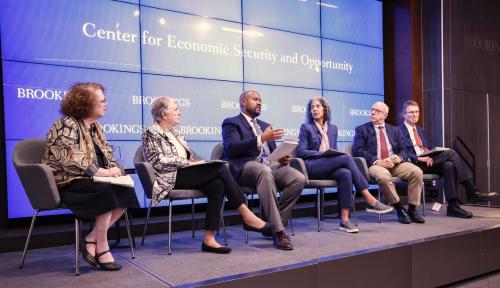This essay is part of the Actionable Ideas for Economic Recovery in American Cities, a feature of the COVID-19 Metro Recovery Watch.
Overview
As the country begins the uncertain process of reopening the economy after COVID-19 lockdowns, economists predict that only 58% of workers are likely to return to their previous job. If that is indeed the case for the 49+ million Americans who have filed an initial claim for unemployment insurance since mid-March, it will leave more than 20 million people searching for a new job. If they want to find a quality job, many of them will need help navigating an uncertain and highly disrupted labor market.
However, the U.S. lacks a strong foundation of programs and services to support adults in making a career transition. This brief outlines a set of comprehensive steps to provide support at all levels of government to help Americans who have lost their jobs in the pandemic connect to new and better employment opportunities during the recovery.
Challenge
In past decades, the U.S. has decreased funding for programs that support adults in finding a new job, also known as “active labor market programs.” The country spends 0.1% of its GDP on active labor market programs, which is one-fifth of the average expenditure for countries in the Organisation for Economic Cooperation and Development (OECD). There is a patchwork of at least 43 separate employment and training programs across nine federal agencies, mostly targeting a specific population of workers such as veterans, people with disabilities, or trade-affected workers.1
The Workforce Innovation and Opportunity Act of 2014 (WIOA) designated six of these 43 programs as “core” workforce programs. These programs are accessed through a WIOA-funded network of more than 2,400 American Job Centers (AJCs), which were intended to serve as a “one-stop” access point for various employment and training programs. AJCs typically offer in-person services and have internet-equipped resource rooms, access to job postings, career exploration tools, and hard-copy resources. Many job center staffers are knowledgeable and passionate, but most job seekers do not receive a high level of individualized attention at current funding levels.
States and local areas have yet to receive significant fiscal aid for reemployment and retraining activities in response to the pandemic, while some workforce areas have reported that their budgets are being cut. AJCs are the “economic emergency rooms” for our society, but many are still closed for in-person services. Only a few job centers have had the capacity to offer remote access or in-person appointments.
Compared to public K-12 education or higher education, the WIOA core programs are quite small in scale. From 2016 to 2017, the U.S. spent an estimated $385 billion on public postsecondary education, but only roughly $14 billion on all 43 employment and training programs in 2017. This includes about $4.6 billion on WIOA core programs for a similar period (2018 to 2019).2 This vast funding imbalance between work-oriented (applied) and academic postsecondary learning remains, despite the fact that 69% of Americans age 25 and over have less than a bachelor’s degree, according to the Census Bureau.
Before COVID-19, the U.S. had 53 million low-wage workers and 11.3 million out-of-work adults. Now, we have tens of millions more unemployed. But the WIOA adult and dislocated worker programs only served about 1.1 million people from July 2018 to June 2019. Only 21.5% of them, or 226,301 people, received WIOA-funded training—most commonly in truck driving. The Wagner-Peyser employment services program serves a high volume of people (including unemployment insurance claimants), but typically can only offer very light-touch services and no job training due to low and declining levels of funding. The below chart shows funding and participation, including participants enrolled in WIOA career services and training.
 Source: U.S. Department of Labor and U.S. Department of Education, PIRL National Performance Summaries, PY 2018. Funding labels are in actual U.S. dollars, and funding symbols are in thousands of U.S. dollars.
Source: U.S. Department of Labor and U.S. Department of Education, PIRL National Performance Summaries, PY 2018. Funding labels are in actual U.S. dollars, and funding symbols are in thousands of U.S. dollars.
The WIOA core programs are federally funded, but they are mainly operated at the state and local level. Governance is decentralized and program-specific, so the programs available and the process for enrolling in them at a given job center can vary greatly. Local service providers are primarily driven by the need to achieve and document successful performance measures to continue receiving funding. Over time, performance reporting requirements have increased alongside funding cuts, giving local areas less flexibility to focus on holistic approaches and requiring staff to spend more time on compliance than direct services.
The end users—a job seeker or an employer—often find it frustrating to navigate these programs. This is partly because the system was built on a philosophy of “self-service,” so most people who come to job centers do not receive a high level of direct staff assistance (typically fewer than 10 of the 43 employment and training programs have staff regularly on-site in most job centers).
Additionally, the programs usually have their own eligibility requirements, authority structures, and application processes, so the user frequently gets passed around to different providers and often must provide the same information multiple times. Many adults who need help finding a job or a training opportunity are unaware that the job centers exist or mistakenly believe they are “unemployment offices,” for accessing unemployment benefits.3 Even if they are aware of the job centers, many job seekers report that the eligibility requirements are confusing.
To complicate matters, few of the programs in job centers directly provide job training. Instead, WIOA-funded training is indirectly channeled to approved training providers in a decentralized manner, further complicating a job seeker’s ability to make informed decisions. Public two-year colleges are the most common training providers for the WIOA core programs, introducing yet another set of governance structures and priorities that do not always align with those in the workforce programs.4 Many two-year colleges now have more students enrolled in noncredit workforce trainings than for-credit academic offerings.
Response
The key elements to a strategy for addressing mass layoffs and supporting adults in their transition to quality jobs include immediate-term mitigation and longer-term recovery efforts. Local areas across the country have already started adapting existing services and infrastructure to meet the new environment’s needs.
Mitigation efforts
The examples below illustrate how local workforce development board leaders are responding and adapting to the crisis.
EmployIndy in Indianapolis: COVID-19 accelerated this organization’s plans to create a multitenant talent matchmaking platform, set to launch in July. They are collaborating with employer and nonprofit partners and setting up data sharing agreements with the state to pull down important fields and information from the UI system so that they can target audiences displaced in the pandemic. EmployIndy has been sending weekly texts to new UI applicants (90,000 and counting in Indianapolis), asking them if they would like to talk with a career navigator and see how their skills transfer to available jobs.
San Diego Workforce Partnership: The Workforce Partnership quickly pivoted to offer its services remotely, including virtual workshops, online job listings, a call center, and a chatbot for services. The Partnership also has a free library of on-demand trainings to help job seekers orient themselves to the job search and access some technology trainings. So far, there are trainings from Coursera, the University of California San Diego, edX, Salesforce, and Microsoft listed on the site.
Workforce Solutions Capital Area in Austin, Texas: Early in the pandemic, Workforce Solutions set up a system to receive and respond to phone calls and launched a COVID-19 resources page. They are building a new mobile-accessible technology hub where individuals can enter basic data about themselves and what services they are interested in, such as finding a job or attending training. The hub connects to an interests and skills assessment that offers the user career suggestions and training providers based on the assessment. It also allows job seekers to opt in to receive text message notifications about events and follow-up information. They decided to build the system because they currently only collect data on a small share of job seekers who enroll in more intensive WIOA services. The organization wants to be able to understand everyone who attempts to access services—including people who use the hub remotely—to determine how to better serve a wider range of job seekers.
Without significant federal investments to enhance partnerships and boost funding for local economic development and career advancement ecosystems, it will be difficult for local leaders to respond in proportion to the need, given that private sector demand is so low.
Recovery
Simply expanding funding for the current programs and infrastructure will not be bold enough to meet the scale of the COVID-19 crisis or to keep advancing skills and business capacity for innovation into the future. We will need to rethink economic security and career advancement policies to stabilize income, connect displaced workers to good employers and quality jobs, and help talent access quality career pathways and support systems that set them up for success.
Stabilizing businesses and consumer income through an ongoing period of uncertainty: Assuming we are facing another year or more of uncertainty due to the pandemic, the U.S. needs to extend expanded unemployment benefits and focus on solutions that give employers the flexibility to manage the ongoing risks of lockdowns and outbreaks while keeping worker incomes stable regardless of fluctuations in demand. Switching workers from unemployment insurance to work share may achieve both of these goals and reduce stress on overloaded state unemployment insurance systems. For example:
- Michigan Governor Gretchen Whitmer has issued an executive order to encourage employers to switch their workers from unemployment insurance to work share. Work share, also known as short-time compensation, allows employers the flexibility to rehire workers at reduced hours and enables workers to continue receiving benefits for lost hours. Employers can retain valuable employees and improve morale while enabling workers to keep their benefits and job. Work share is normally a layoff-aversion program, but the U.S. Department of Labor has issued guidance on how states can use it for rehiring as well.
Connecting talent to in-demand, quality jobs: Demand for labor has collapsed, which calls for large public investments in transitional jobs, public service jobs, and infrastructure jobs. We can also connect talent with small business incubation opportunities, entrepreneurship training, and downtown community-rebuilding efforts. Policymakers need to be strategic about investing in programs that offer direct links into high-wage jobs—for example, efforts to recruit contact tracers should provide clear off-ramps into permanent careers. This also means targeting employer engagement to employers that demonstrate a shared commitment to job quality, safety, equity, and career advancement. Businesses can play a bigger role in producing the skilled workforce they need in exchange for greater support and incentives from the government during this crisis. For example, they can offer job seekers an entryway to a new workplace through subsidized employment or apprenticeships. States can also expand incumbent worker training programs to incentivize employers to invest more in training. Examples include:
- California has an incumbent worker training program called the Employment Training Panel, which reimburses employers for worker training. A recent evaluation found that the program had significant and positive impacts on sales and employment size, especially for small- and medium-sized businesses. States could use programs such as this to help stimulate the recovery of small- and medium-sized firms and improve access to economic opportunities for workers.
Building an affordable, holistic system for supporting transitions into new career pathways: There is growing evidence that solutions which combine training with wraparound services based on a sector-based career pathway approach are more successful than existing WIOA training programs that incentivize the placement of adults and dislocated workers in one-off, short-term trainings and low-wage jobs. We need to establish clear on-ramps to career pathways with applied learning opportunities, one-on-one career coaching, professional networking opportunities, and supportive services such as child care. For example:
- The Trade Adjustment Assistance Community College and Career Training (TAACCCT) grant program represented an almost $2 billion investment in sector-based community college career pathways designed to meet the holistic career advancement needs of adult learners. Evaluations of these grants are available in a central repository.
- The Health Profession Opportunity Grants program also offered mixed-method evidence related to student success in health-career pathways.
It is not possible to scale these holistic models in a fragmented system with short-term performance measures and low funding levels. The U.S. needs permanent higher education funding streams for public colleges and universities to offer applied pathways, so that adults can more easily earn income while learning. In addition, the “self-service” approach underlying current programs is rooted in the deeply flawed assumption that job seekers have equal access to information. Making one-on-one career guidance and mentorship more available to any job seeker would help them understand how to effectively signal their skills in a new field and what the progressions for advancement are. Free guides to the job search process and opportunities for professional networking also need to be much easier to find. Building infrastructure to access holistic career pathways remotely could help us achieve economies of scale in service delivery, while also addressing the ongoing threat of COVID-19.
When redesigning this system, policymakers should gather direct input from job seekers and business leaders based on principles of human-centered design, to ensure that programs will add value for those who use them. Human-centered design can also be used to modernize wage record reporting, participant reporting, and unemployment insurance systems, when combined with appropriate reforms to streamline programs and automate many aspects of outdated government technology systems.
Funding
The recovery strategy outlined above will require a much more robust investment in an economic security and career advancement system to counteract inequality. The proposed HEROES Act legislation in Congress would roughly double the funding for WIOA adult, dislocated worker, and youth programs (Program Year 2018 expenditures on those programs were about $2 billion). This seems wholly inadequate to match the scale of the problem. At a minimum, we should aim to match the average of what other OECD countries spend on active labor market adjustment programs. Based on current estimates of GDP and expenditures in the OECD data, that means increasing U.S. investments in active labor market programs by about $86 billion.
In many regions, local workforce boards are trying to identify innovative ways to partner with other organizations to raise funding through private philanthropy. Generally speaking, however, these efforts are just starting to get off the ground. Given that WIOA training participants currently only receive about $1,900 to $2,600 per participant, on average, a goal of reaching a $10,000-per-participant investment seems reasonable, assuming the high costs of providing holistic services and quality reskilling opportunities, not to mention the need to compensate for historical legacies of underinvestment in communities of color. We should revisit our funding allocation formulas for workforce investments to include variables for underemployment, such as a high share of workers with unstable hours, temporary positions, or very low-wage jobs.
Potential impact
The U.S. must immediately come up with a disaster plan for American Job Centers, preparing them for an unprecedented throng of job seekers that need help. The country must also use this opportunity to break the cycle of long-term underinvestment in critical labor market adjustment infrastructure to ensure that the COVID-19 pandemic does not further exacerbate economic inequality. With adequate investments, a system that provides clear and affordable career pathways to quality jobs, and intentional efforts to address information asymmetries and social exclusion from high-wage occupations, local and state actors can come together to meet the challenges of the current moment.
We need to go beyond immediate relief, and not only reimagine a more equitable society, but also bring it into being with institutions and robust investments. We have many assets to leverage—the tremendous potential of our talent, existing evidence and applied knowledge about what works, and the vast wealth in our country—that will allow us to rebuild in a way that offers more access to opportunity.
-
Footnotes
- The GAO report excluded education funding streams that adult learners commonly use, such as those available through public two-year colleges (technical and community colleges) and funded by Pell Grants or other forms of federal student aid.
- Source: U.S. Department of Labor and U.S. Department of Education PIRL reports for PY 2018.
- Unemployment offices largely disappeared in the 1990s as benefits systems migrated to call centers.
- Note: nonprofit and for-profit training providers are also allowed to receive WIOA adult or dislocated worker funding for training if they are approved for the Eligible Training Provider List.




